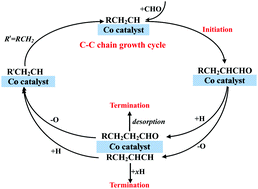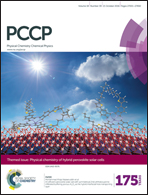Insight into the mechanism about the initiation, growth and termination of the C–C chain in syngas conversion on the Co(0001) surface: a theoretical study†
Abstract
The initiation, growth and termination mechanism of the C–C chain from syngas on the Co(0001) surface have been investigated using DFT calculations. Our results show that CHx (x = 1–3) formation is easier than CH3OH, both CH and CH2 species are the dominant forms of CHx (x = 1–3), both CH and CH2 species dominantly interact with CHO to form CHCHO and CH2CHO, and realizes the initial C–C chain formation. Then, CHCHO and CH2CHO prefer to be successively hydrogenated to CH3CHO, followed by C–O bond cleavage to give CH3CH; subsequently, CHO insertion into CH3CH can realize the further chain growth to form CH3CHCHO, followed by dissociation and hydrogenation to give CH3CHCH and CH3CH2CHO, respectively; further, CH3CHCH hydrogenation or CH3CH2CHO dissociation via the C–O bond cleavage can form the CH3CH-like species CH3CH2CH intermediate. Thus, the mechanism of a C–C chain growth cycle has been proposed that starts from a CH3CH2CH intermediate, followed by repeating the above C–C chain growth cycle via CH3CH intermediates, and the C–C chain growth to higher C2+ hydrocarbons and oxygenates can be realized, in which RCH2CH prefers to interact with CHO to form RCH2CHCHO, followed by its C–O bond cleavage and its hydrogenation to form R′CHCH (R′ = RCH2) and R′CH2CHO (R′ = RCH2), respectively, where R′CHCH hydrogenation and C–O bond cleavage of R′CH2CHO will produce R′CH2CH. Moreover, aldehyde intermediates R′CH2CHO are expected to undergo C–O bond cleavage to five R′CH2CH (R′ = RCH2) rather than its desorption and its hydrogenation to alcohol. The C–C chain termination occurs at three possible positions along the growth cycle: R′CH2CHO desorption, R′CHCH with successive hydrogenation steps to alkanes or alkenes, and R′CH2CH hydrogenation to alkanes, in which the relative importance of termination of R′CHCH and R′CH2CH with hydrocarbons will depend strongly on the hydrogen coverage on the metal surface. The results of this work not only illustrate the initiation, growth and termination mechanism of the C–C chain involved in FTS on the Co(0001) surface, but also serve as a basis for the rational design of other Co surfaces toward desirable higher hydrocarbons or oxygenates.


 Please wait while we load your content...
Please wait while we load your content...